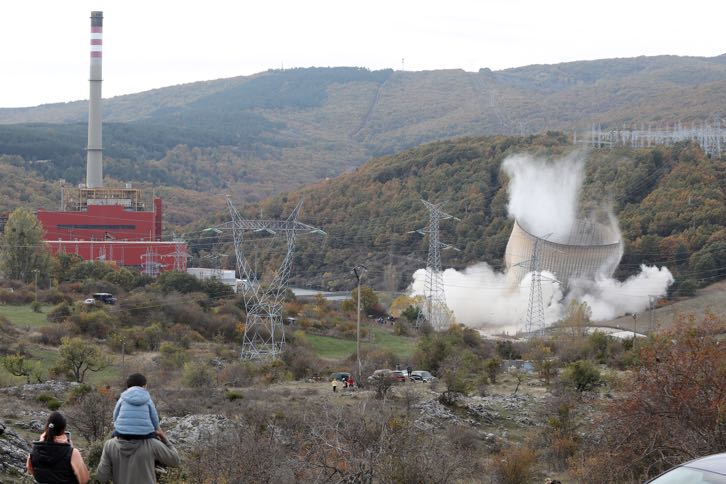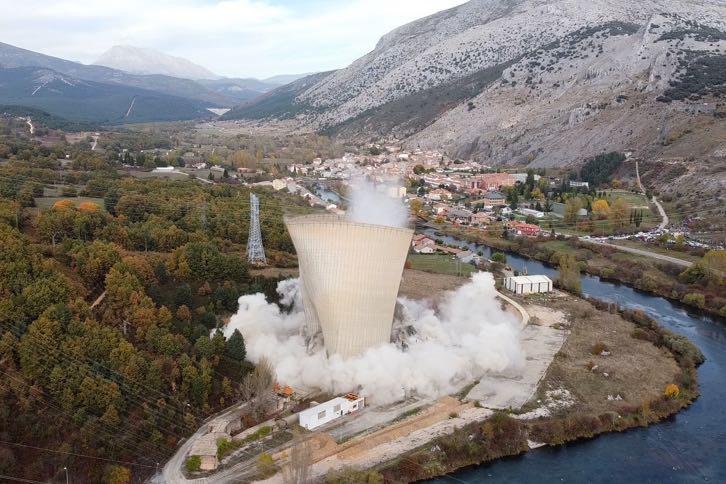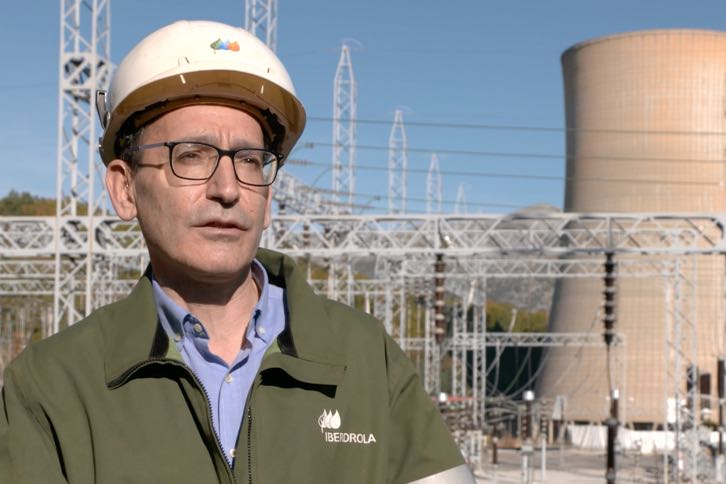News
Positioned as a leader in the fight against climate change on the eve of COP26, Iberdrola is the largest electricity company in the world without coal production and is advancing towards its goal of becoming emission-neutral in Europe by 2030
The demolition at the Velilla thermal power plant is a giant step towards a greener, more competitive and sustainable economy
- At 16.05, the power plant cooling tower was demolished by controlled explosion without environmental impact: electronic detonators were used, and the concrete rubble and metal structure will be recycled
- The work to dismantle the power plant, now 35% complete, is being carried out by suppliers and 50 specialised workers, half of them locallocales
- Iberdrola's investment plan in Castilla and León entails installing 1,800 green MW in the coming years · The transformation of Velilla includes the construction of one of the region's largest photovoltaic complexes, as well as smart grids and sustainable mobility, circular economy projects and a Citizen Innovation Platform to encourage entrepreneurship
At 16.05, the cooling tower at the Valilla del Río Carrión thermal power plant in Palencia was demolished as part of the dismantling work, 56 years after it was commissioned and 15 months after closure. The step was ordered at the end of 2017. The controlled explosion was a symbolic moment in our country's transformation into a green, competitive, sustainable economy. Since 2001, Iberdrola has closed 17 thermal coal and fuel oil fired power plants around the world, most recently in Velilla and Lada in Spain. Positioned as a leader in the fight against climate change in the countdown to COP26, the company is the world's largest coal-free electricity utility and is firmly committed to achieving emissions neutrality by 2030 in Europe.
Velilla was demolished under safe conditions with only minimal environmental impact. The one-hundred-metre high tower, which weighed more than 7,000 tonnes, was demolished using 82 kg of explosives and was electronically detonated. The demolition technique used is one of the most efficient for dismantling power plants. It reduces the risk to workers, encourages the circular economy and helps to reduce the environmental impact. The concrete and metal structure will be recycled.
Five-second collapse and pre-emptive evacuation
Following the explosion, the cooling tower fell in on itself vertically with a slight tilt to the north, it did not fall over, this enabled the debris to be contained on the opposite side of the river from the main plant. Following stability calculations, work to weaken the tower was carried out and, on detonation, the explosive charges fragmented the supporting pillars, causing the tower to lose its balance and collapse under its own weight. It took just five seconds for the structure to collapse after the explosion.
The isolated location of the power plant and of the cooling tower on the site posed no threats to other buildings, although everything took place under tight security and Velilla del Río Carrión Town Council and other competent authorities were notified. Workers checked for bird nests and other animals and the area was evacuated temporarily, leaving a safety perimeter of 250 metres.
Highly qualified suppliers and professionals
The cooling tower was demolished as part of the dismantling of the entire power plant, a process that is now 35% complete and that will continue for another 48 months.
The work is involving a large number of suppliers -many local and with a higher workload than during the operation of the power plant- and around 50 professionals. Nearly half come from central and local contractors; they are highly qualified workers with extensive experience with this type of technically complex project.
Green transformation of the area
Investments in 100% renewable projects, stimulation of the business sector and local employment based on green principles and innovation and support for entrepreneurship are the ways in which Iberdrola is transforming the Velilla del Río Carrión region.
The company has a renewables plan in Castilla y León for the coming years that includes the installation of 1,800 MW of both wind and photovoltaic renewable energy, with a planned investment of 1.3 billion euros. In Velilla it is building one of the region's and Spain's largest photovoltaic complexes (350-400 MW) with an investment of 300 million euros. Iberdrola is the leader in renewable energy in the region, operating 5,200 MW, making this the autonomous region where the company has installed the most green megawatts.
The project to transform Velilla also includes investments in smart grids and sustainable mobility, circular economy projects and a Citizen Innovation Platform to encourage entrepreneurship.
Pioneers in the energy transition
At the end of 2017, Iberdrola requested authorisation to close its last remaining thermal power stations in the world, located in Velilla (Palencia) and Lada (Asturias), following its decision to replace CO2 emitting facilities with the latest generation clean energy sources, thereby leading the energy transition towards a new sustainable energy model.
Iberdrola continues to make progress with its sustainability strategy, based on the electrification of the economy and oriented towards the fight against climate change and the creation of wealth and employment in the communities in which it operates.
The company is a leader in green, sustainable financing, with 35.8 million euros and is the global leader in green bond emissions. Its CO2 emissions as of September have been reduced to 53 g/kWh and it maintains its goal of becoming an emission-neutral company by 2030 in Europe.
In the last two decades, the company has invested 120 billion euros in renewable energies, smart grids and energy storage. An investment plan to 2030 worth 150 billion euros will triple its renewable capacity to almost 100,000 MW.










